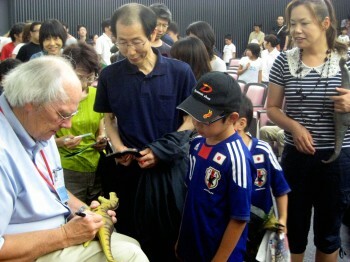Millions to see Museum of the Rockies dinosaurs on Asian tour
Friday Jul. 22nd, 2011

Jack Horner, MOR Curator and Regents Professor of Paleontology, autographs toy dinosaurs for Japanese children at the grand opening of the Museum of the Rockies dinosaur exhibit at the Fukui Prefectural Dinosaur Museum in Japan in early July. Photo courtesy of the Museum of the Rockies.
The exhibition, containing many casts of fossils from the Museum of the Rockies (MOR) and around 15 actual fossils from the MOR collection, includes “Custer,” the world’s largest T.rex skull.
“Visitors to the exhibition will know these fossils come from Montana, the Museum of the Rockies and Montana State University. This is an incredible opportunity for us to share Montana’s treasures with an international audience,” said Shelley McKamey, MOR executive director.
The Fukui Prefectural Dinosaur Museum is expecting around 300,000 visitors in three months this summer while the exhibit is on display. For comparison, the Museum of the Rockies sees roughly 150,000 visitors for an entire year.
Once the exhibition leaves Fukui, it will travel to more than seven other museums throughout Japan, Taiwan, and possibly Singapore and mainland China.
“Dinosaurs are one way kids can begin to get excited about science,” said Jack Horner, MOR Curator and Regents Professor of Paleontology.
“The kids that see this exhibition may be the same ones solving bigger scientific challenges such as nuclear power concerns, tsunami safety, and other regional issues in the future. We hope this exhibit will inspire those learners,” Horner said.
The MOR team was committed to ensuring that the exhibition opened on time and as planned for the Japanese.
“We felt this exhibition was too important not to travel to Japan even in light of the recent earthquakes,” McKamey said. “The people of Fukui definitely seemed to appreciate that we honored our commitment to this partnership.”
MOR also partnered with the Japanese company, Kokoro, which specializes in animatronics and robotics. Kokoro was responsible for creating a full-size T.rex for the exhibition complete with motion and sound.
This is the first time MOR has put on a traveling exhibit on the maturation of dinosaurs from juveniles to adults, and it has been more than 20 years since the museum sent any of its collection out of the United States.
“This is the most cutting-edge dinosaur research currently out there, and we are thrilled to share these findings in such an exciting way to an international audience. In addition, we are planning a similar exhibit to tour in the United States beginning in the fall of 2012,” MOR Exhibits Director Pat Leiggi said.
Under the direction of Horner, all the research that is contained in the exhibition has already been on display at the Museum of the Rockies. Horner’s intention is to always have the most recent research available to the local community first before sending it abroad.
Curating the exhibition for the Fukui Prefectural Dinosaur Museum is Masateru Shibata, a former MSU student and protégé of Horner’s. Shibata translated Horner’s lecture on the weekend of the opening. Horner also spent time with Japanese paleontologists, including Shibata, sharing research,
visiting a dig site and discussing current findings and practices in paleontology.
“I think I can speak for both the Japanese and myself when I say how pleased we were with the educational opportunity this provided between Japan and the U.S. in the field of paleontology,” Horner said.
The exhibit focuses on the growth and behavior of dinosaurs, particularly the Tyrannosaurs Rex and Triceratops. Just in the past year, Horner has co-authored two papers on the growth stages of dinosaurs. Last July, Horner and MSU doctoral student John Scannella published a paper arguing that the Torosaurus was really a mature Triceratops. In June, Horner and MSU doctoral student Denver Fowler published a paper arguing that Raptorex kriegsteini was a juvenile of another species, possibly a Tarbosaurus bataar.
“We’re beginning to understand that many of the specimens we see are not distinct species, but different life stages of the same creature,” Horner said.
The Museum of the Rockies developed the exhibition using funds from the profits of past traveling exhibitions and plans to invest revenue made through the Asia tour into future MOR traveling exhibitions. The grand opening for the exhibit in Fukui was the weekend of July 8-10 in which
McKamey, Leiggi, and Horner attended. Through the exhibit, the Museum of the Rockies and Fukui Prefecture Dinosaur Museum have become sister museums.
Fukui is on the west side of the main Japanese island of Honshu, roughly 11 miles from the coast with the Sea of Japan and several hundred miles from the area devastated by the March earthquake and tsunami. The Japanese have found a number of notable dinosaur fossils in the region around Fukui,
including the famous Fukui Raptor.
| Tweet |